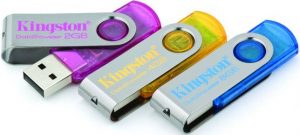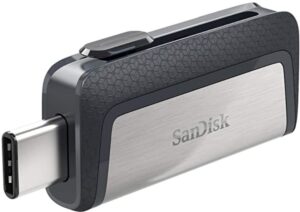SuperSpeed and Hi-Speed, high-capacity USB flash drives/memory sticks/thumb drives
CONTENTS
1. – This page – Introduction to high-speed, high-capacity USB flash drives/memory sticks
2. – Reviews of USB Flash Drives
3. – Microsoft’s Flash Drive Manager
4. – How to write-protect a flash/thumb/key/pen drive
5. – Using ReadyBoost with a flash drive in Windows Vista/7/8.1/10 to improve performance
6. – Bootable USB flash drives
Introduction

Flash drives come in all kinds of shapes, sizes and capacities. They use flash memory that allows huge amounts of data to be stored in a small, portable device that can be attached to a key-ring. The capacities of flash drives are now so large and the drives are now so relatively inexpensive that they are replacing CD, DVD and Blu-ray discs for storing data and also for bootable system-repair devices. Windows 10 only creates a repair flash drive. Previous versions of Windows create a repair CD/DVD disc.
Flash memory, sometimes called Flash RAM, was invented by Intel. It is now very fast when reading data or having data written to it, but unlike RAM memory, which loses its data when its source of power is switched off, it is non-volatile, which means that it retains the data when the power is switched off or the flash-memory device is removed from a system.
Flash memory – https://en.wikipedia.org/wiki/Flash_memory
Devices that employ flash memory and which use the USB interface are called by several names – flash drives, keys, memory sticks, USB sticks, jump drives, key drives, pen drives, thumb drives, etc. The latest flash drives use the latest USB 3.0 standard, but new USB 2.0 drives are still available.
Note that your computer has to provide USB 2.0/3.0/USB-C ports, or they have to be added to both a desktop or laptop PC via a PCI or PCI Express adapter card. USB 3.0 is backwards-compatible, so USB 3.0 devices can use the earlier USB versions, 2.0 and 1.1 when plugged into their ports on computers that have no USB 3.0 ports.The USB-C standard uses a different connector that does not fit into standard, backwards-compatible USB ports. The image below shows a Sandisk USB-C flash drive.

All memory cards, such as CompactFlash and SD, use flash memory. Flash memory is also used in solid-state drives (SSDs) that can be used in desktop and laptop computers instead of conventional hard disk drives (HDDs). An SSD drive uses much less power than a conventional hard drive, and it can withstand shocks (when a laptop is dropped, etc.), that would destroy hard drives. SSDs have reached much higher capacities than was the case only a few years ago, but their capacities are still far behind those of HDDs and by July 2015 they were still costing around four times as much as HDDs of the same storage capacity.
Hard Disk and SSD Drives –
https://www.pcbuyerbeware.co.uk/hardware/disk-and-ssd-drives/
External Hard Disk, SSD & NAS Drives –
https://www.pcbuyerbeware.co.uk/hardware/hard-disk-and-ssd-drives/external-hard-disk-drives/
It is possible to buy flash drives that are waterproof, that have the cap attached to the drive so that it can’t be lost, that slide their USB connector in an out of the device or which don’t appear to have a connector but which can just be pushed into a USB port. Integral makes waterproof flash drives.
The major manufacturers of flash drives are SanDisk, Kingston, Toshiba, Integral, Corsair, Verbatim and Transcend. There are several other less well-known manufacturers. Search Amazon for USB flash drives to see the ranges of manufacturers and capacities that range from 4GB to 1TB (February 2021)).
The prices are now so affordable and the capacities are now so high with the sizes of the drives similarly small that memory sticks are making CD/DVD/Blu-ray optical disc drives redundant for storage purposes.
The largest flash drives currently available By Jon Martindale January 23, 2021 –
https://www.digitaltrends.com/computing/largest-flash-drives/